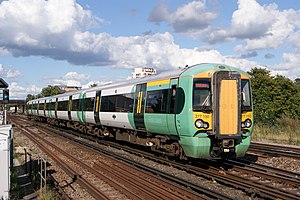
Back Bombardier Electrostar German Electrostar French Electrostar Hungarian エレクトロスター Japanese Electrostar SIMPLE Bombardier Electrostar Ukrainian
This article needs additional citations for verification. (January 2024) |
| Bombardier Electrostar | |
|---|---|
 A Southern Class 377 approaching Norwood Junction in 2015 | |
| In service | 2000–present |
| Manufacturer |
|
| Built at | Derby Litchurch Lane Works |
| Replaced | |
| Constructed | 1999–2017 |
| Number built | 679 trainsets, 2704 carriages |
| Number in service | 649 trainsets |
| Successor | Alstom Aventra |
| Formation | 3, 4 or 5 cars per trainset |
| Capacity | Varies depending on number of carriages and seating configuration, see individual articles for details |
| Operators | |
| Specifications | |
| Car length | |
| Width | 2.80 m (9 ft 2 in) |
| Height | 3.78 m (12 ft 5 in) |
| Maximum speed |
|
| Weight |
|
| Power output |
|
| Electric system(s) | |
| Current collector(s) |
|
| Safety system(s) | |
| Track gauge | 1,435 mm (4 ft 8+1⁄2 in) standard gauge |
The Bombardier Electrostar (sold as the ADtranz Electrostar until 2001) is a family of electric multiple-unit (EMU) passenger trains manufactured by Bombardier Transportation (formerly Adtranz) at their Derby Litchurch Lane Works in England between 1999 and 2017. It has become the most common new EMU type in the United Kingdom since the privatisation of British Rail with a number of variants. Electrostar trains are most common on high-volume suburban commuter routes around London; and on mainline services from London south to Surrey and the south coast, east to Essex, and north to Cambridge and Stansted Airport.[citation needed]
The model shares the same bodyshell and core structure as the Bombardier Turbostar which is the most common post-privatisation diesel multiple unit (DMU) family; both evolved from the Class 168 Clubman design by ADtranz. The Turbostar and Electrostar platforms are a modular design, sharing the same basic bodyshell and core structure, and optimised for speedy manufacture and easy maintenance. A common underframe, created by seam-welding a number of aluminium alloy extrusions, is covered by body panels and topped by a single piece roof, again made from extruded sections. Car ends (cabs) are made from glass-reinforced plastic and steel, and are bolted onto the main car bodies. Underframe components are collected in "rafts" which are bolted into slots on the underframe. The predominantly aluminium-alloy body gives light weight to help acceleration and energy efficiency.[citation needed]
The Electrostar was selected for use on the Gautrain system in South Africa, a new railway between Johannesburg, Pretoria, and the Johannesburg International Airport.[citation needed] The trains were assembled by UCW Partnership in South Africa from components made in Derby.[3]
Transport for London (TfL) announced in August 2006 that it had ordered 48 three- and four-car Electrostar trains for the new London Overground service.[4] These were categorised by Network Rail as Class 378, and entered service in 2009 to replace the Class 313 and Class 508 trains on the North London Line and West London Line, and to provide the opening service on the new East London line extension in 2010.[5]
In 2009, as part of the government's wider rolling stock plan, an order was placed for thirty four-car Class 379 Electrostar units intended for use by National Express East Anglia (now operated by Greater Anglia) on the Stansted Express and West Anglia services.[6] The first of these units entered passenger service on Thursday 3 March 2011.
Production of the trains ended in 2017 when unit number 387174 for Great Western Railway was completed at Derby Litchurch Lane Works.[7] The family was superseded by the Bombardier Aventra.[citation needed]
- ^ Pritchard, Robert (2022). British Railways Locomotives & Coaching Stock 2022. Sheffield: Platform 5 Publishing. pp. 289, 297. ISBN 978-1-909431-97-3.
- ^ Pritchard 2022, p. 298.
- ^ "Bombardier Selected Preferred Bidder for Rapid Rail System in South Africa". Bombardier. 2 July 2005. Archived from the original on 22 July 2011. Retrieved 15 October 2012.
Bombardier Transportation's facility in Derby, United Kingdom, will be responsible for manufacturing the fleet of Electrostar vehicles, with final assembly performed in South Africa by UCW Partnership, a broad-based empowered subsidiary of Murray & Roberts.
- ^ "London Overground Suburban Network". Railway Technology. Retrieved 28 September 2024.
- ^ "TfL awards £223m new trains contract". Transport For London. 31 August 2006. Archived from the original on 11 March 2007. Retrieved 15 October 2012.
Funded by TfL's £10 billion Investment Programme, the new trains will operate on the North London Railway, which TfL will manage from November next year, and the extended East London Line.
- ^ "Express delivery". Railfuture. 4 April 2009. Retrieved 19 July 2010.
- ^ "Last-ever Electrostar finished in Derby as 18 years of production come to an end". Rail Technology Magazine. 28 November 2017.
The final carriage marks the 2,805th to be constructed at Bombardier's Derby Litchurch Lane facility, with engineers, company bosses and local MP Margaret Beckett attending a sending-off ceremony to celebrate to the occasion.